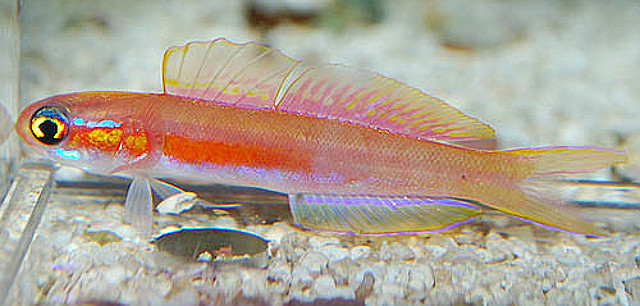A mysterious new species belonging to the little-known genus Navigobius has just surfaced from Vietnam. Navigobius might not be quite so familiar a name among aquarists as some of its relatives (e.g. Nemateleotris, Ptereleotris), but this small group has some of the most stunning members within the diverse dartgoby lineage. The only two previously known species, N. dewa and N. vittatus, are both adorned in a vivid mix of bright pinks, purples and yellows, and we can probably expect the same sort of vibrancy from the newly minted N. khanhoa. Unfortunately, only a single specimen of this fish is known, and its coloration was not recorded before it was preserved in alcohol.
Without knowing what color patterns might distinguish N. khanhoa, identification requires a careful count of some morphological features. The most easily recognized trait is the unusually high number of dorsal fin rays (26 vs. 11-14 in N. vittatus, 20 in N. dewa). Not only does this allow us to tell N. knanhoa from these species, but it also allows us to distinguish this fish from another undescribed species which has been trickling into the aquarium trade from the Maldives and the Philippines. While N. dewa, N. vittatus and N. cf dewa all have good photographic documentation (both in the wild and in captivity), there truly does not seem to be a single image of this new Vietnamese species.
https://youtu.be/UAYxDVha8IE?t=2m21s
Navigobius are generally reported from depths of 30 meters or more in sand-rubble habitats, often in the cooler waters found beneath a thermocline. Navigobius khanhoa is named for Khanh Hoa Province, Vietnam, where the type specimen was collected by trawling at depths of 29-44 meters in Nha Trang Bay. In these sorts of reef-adjacent habitats, Navigobius are found hovering in small groups, as is typical for dartgobies, and will quickly retreat back into their sandy burrows when approached.

Navigobius cf dewa is another undescribed species. This aquaruim specimen originated from the Maldives. Note the number of dorsal fin rays (~20) is far less than in N. khanhoa. Credit: Aquarise
It’s remarkable how quickly this genus has grown in just a few short years. It was only in 2009 that Navigobius dewa was described (though it had been known to Japanese divers for some time prior), and N. vittatus made itself known around the end of 2015. In addition to N. khanhoa, there are probably at least two more species in need of description: the aforementioned N. cf dewa from the Maldives and another similar fish from the Philippines and Japan. And who knows how many more of these little dartgobies might end up being discovered once their habitats are better explored. Is there another new Navigbius waiting to be found in Africa or Australia or Polynesia? Probably.
Prokofiev, A.M., 2016. Gobies (Gobioidei) of soft bottoms from Nha Trang and Van Phong bays (South China Sea, Vietnam). Journal of Ichthyology, 56(6), pp.799-817.











0 Comments